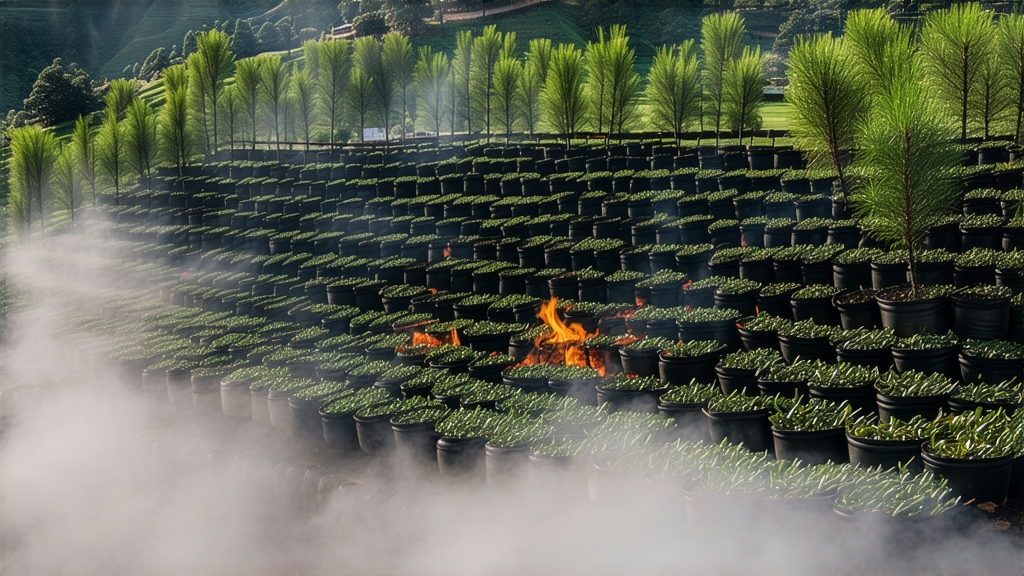
When most tea lovers outside China hear “black tea,” they picture a brisk Ceylon or a malty Assam, yet the very word “black” was first applied to the tiny, twisted leaves that emerged from the Wuyi Mountains of northern Fujian in the mid-seventeenth century. That original black tea is Lapsang Souchong, still produced today in the same granite gorges where cliffs press against the Nine-Bend River and morning mists linger long enough to perfume the air with pine resin. To understand global tea culture—why the British added milk, why the Dutch floated tulip-shaped cups, why Russians sweeten with jam—one must begin with this smoky ancestor whose story is written in camphor-scented smoke and the salt-sweet breath of the South China Sea.
-
From Song to Smoke: a concise history
During the Song dynasty (960-1279) the Wuyi region was already famous for compressed “dragon” tea cakes carried north along the Tea-Horse Road. When the Ming court abolished compressed tribute tea in 1391, local monks and farmers turned to loose-leaf oolong, pan-firing leaves in iron woks set between temple pillars. A century later, passing Qing armies demanded such large quantities that villagers sped up drying by burning local Masson pine beneath bamboo trays. The accidental smoke infusion proved popular with the Dutch traders anchored at Xiamen, who bought every “bohea” (the Fujianese pronunciation of “Wuyi”) they could load. By 1640 the first chests reached Amsterdam; by 1662 Catherine of Braganza had introduced the novelty to the English court, and “souchong”—from xiao zhong, “small sort”—entered the lexicon of luxury. The East India Company soon specified “smoke-dried black tea” in its Canton contracts, and Lapsang Souchong became the template for every black tea that followed. -
Two families, one mountain: Zheng Shan vs. Waishan
Purists divide Lapsang into two geographic camps. Zheng Shan (“original mountain”) is grown inside the 60 km² core scenic reserve at 600–1,200 m, where acidic red gravel soil forces slow growth and concentrates aromatic oils. Only six villages—Tongmu, Guadun, Miaowan, Huang gang, Guang lou, and Ren shan—may claim the name. Here the cultivar is predominantly Xiao Ye Zhong (“small-leaf species”), a close cousin of the wild tea trees that carpet the lower slopes of the Wuyi massif. Waishan (“outside mountain”) refers to identical cultivars transplanted to counties such as Jianyang, Guangze, or even Jiangxi and processed in the same style; the leaf is larger, the smoke lighter, the price gentler. Both styles share the same four-grade ladder—King, Supreme, Extra, and Standard—but only Tongmu lots carry the European Union’s Protected Designation of Origin (PDO) seal introduced in 2003. -
The craft: withering over pine, firing over embers
Plucking begins in late April, when two leaves and a bud still wear the spring dew. The baskets are bamboo, the transport downhill by motorbike before the sun grows hot. Inside dark wooden sheds, bamboo racks called qing qiao are suspended two meters above a shallow pit where pine logs smolder at 40 °C for the first two hours; this gentle “warm smoking” replaces the sun-withering used for unscented black teas. Masters judge moisture by the sound of a squeezed leaf: a faint crunch means 65 % water remains, the cue to roll. Rolling is still done on 150-year-old fir tables, the top plank replaced every decade but the legs darkened by generations of tea juice. Oxidation follows in cloth-lined wooden boxes for three to five hours until the leaf turns a uniform copper-maroon. The critical “firing over ember” comes next: long strips are tossed onto sieves set 70 cm above glowing pine charcoal, the temperature rising to 80 °C then dropping to 50 °C in a rhythmic dance that prevents baking yet fixes the smoky signature. Finally, a “cold smoke” phase: embers are extinguished, fresh pine needles are laid on the coals, and the leaf rests for thirty minutes while resinous vapor drifts upward. Total production time: roughly 24 hours, 80 %